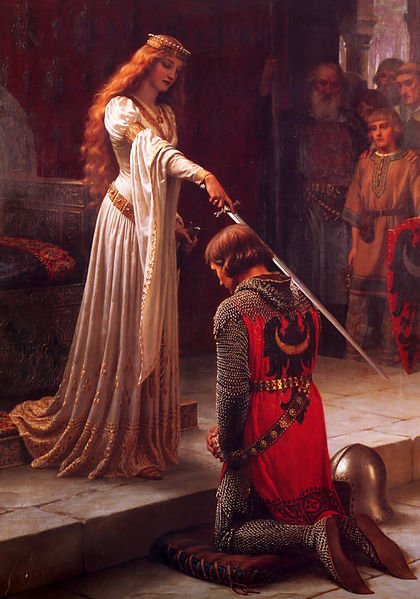Installation of the Order of the Bath
Chivalric Orders, Chivalry, England, Order of the Bath, Traditions

Edmund Blair Leighton, The Accolade, 1901, Private Collection.
Clive Aslet, in the Telegraph, reports that today Queen Elizabeth II will be presiding over ceremonies linking today’s Britain with the chivalrous traditions of the Middle Ages.
Foreign tourists in the vicinity of Westminster Abbey today, may be in luck. They’ll glimpse Her Majesty the Queen participating in a ceremony that only enters her diary once every eight years: the Installation of the Order of the Bath.
Like the Woolsack, hunting with hounds and the last of the hereditary peers, it’s a piece of traditional pageantry that escaped the reforming zeal of New Labour – perhaps because it is so arcane that they failed to notice it. Certainly most Britons, were they to see the parade of Knights Grand Cross or Knights Commander (Dames too, now), in their gorgeous crimson satin mantles, freighted with stars and tassels, would be as flummoxed as visitors from overseas.
What’s going on? Can there be any earthly point in such flummery, as the nation – otherwise dressing down on Fridays – struggles with the challenges of modern life?
Scrape beneath the surface and the ritual turns out to be more interesting than one might suspect. As a body of knights, one couldn’t expect them to do much practical defending of the faith. It is one of the few occasions in the year when Her Majesty can be sure of being in the company of distinguished people who make her seem, in comparison with their years, positively youthful.
But the ceremony is also an instance of the British ability to preserve and reinvent tradition. You would have to be a firebrand Roundhead to object to something so abstruse, so harmlessly picturesque as the Most Honourable Order of the Bath. And yet it also serves, however obliquely, as a reminder of the chivalric values that – whether or not doors are still held open for ladies – underpin our sense of public virtue. Does honour mean anything, in these fallen days of cash for questions and parliamentary expenses scandals? It does here.
Republicans might object that today’s ceremony, held in Henry VII’s chapel at Westminster Abbey, where the Sovereign and the most senior Knights and Dames Grand Cross will occupy stalls in the choir, is an anachronism. Of course it is. That is – and always has been – the point about chivalry. Even in the Middle Ages, it was a romantic throwback to a supposed golden age. Washing ceremonies – yes, the Order of the Bath really is to do with bathing, not a place in Somerset – appear at William I’s coronation, but the touchstone of chivalry was located in an era that far predated him.
Read the whole thing.
Wikipedia entry.





